Effects of Electrical Stress in Solution-Processed Spin-On Glass Dielectric Films: Frequency Dependence †
Abstract
:1. Introduction
2. Materials and Methods
3. Results and Discussion
4. Conclusions
Supplementary Materials
Funding
Data Availability Statement
Acknowledgments
Conflicts of Interest
References
- Karim, K.; Nathan, A.; Hack, M.; Milne, W. Drain-Bias Dependence of Threshold Voltage Stability of Amorphous Sil-icon TFTs. IEEE Electron. Device Lett. 2004, 25, 188–190. [Google Scholar] [CrossRef]
- Takagi, K.; Nagase, T.; Kobayashi, T.; Naito, H. High operational stability of solution-processed organic field-effect transistors with top-gate configuration. Org. Electron. 2016, 32, 65–69. [Google Scholar] [CrossRef]
- Wahl, R.E.; Wang, F.; Chung, H.E.; Kunnen, G.R.; Yip, S.; Lee, E.H.; Pun, E.Y.B.; Raupp, G.B.; Allee, D.R.; Ho, J.C. Stability and Low-Frequency Noise in InAs NW Parallel-Array Thin-Film Transistors. IEEE Electron. Device Lett. 2013, 34, 765–767. [Google Scholar] [CrossRef]
- Jeon, J.; Kim, J.; Ryu, M. Instability of an Amorphous Indium Gallium Zinc Oxide TFT under Bias and Light Illumi-nation. J. Korean Phys. Soc. 2011, 58, 158–162. [Google Scholar] [CrossRef]
- Dominguez, M.A.; Pau, J.L.; Redondo-Cubero, A. Stability of zinc nitride thin-film transistors under positive and negative bias stress. Solid-State Electron. 2020, 171, 107841. [Google Scholar] [CrossRef]
- Jeong, Y.; Bae, C.; Kim, D.; Song, K.; Woo, K.; Shin, H.; Cao, G.; Moon, J. Bias-Stress-Stable Solution-Processed Oxide Thin Film Transistors. ACS Appl. Mater. Interfaces 2010, 2, 611–615. [Google Scholar] [CrossRef] [PubMed]
- Jeng, J.-S. Improvement of transistor characteristics and stability for solution-processed ultra-thin high-valence niobium doped zinc-tin oxide thin film transistors. J. Alloy. Compd. 2016, 676, 86–90. [Google Scholar] [CrossRef]
- Su, B.-Y.; Chu, S.-Y.; Juang, Y.-D.; Liu, S.-Y. Effects of Mg doping on the gate bias and thermal stability of solution-processed InGaZnO thin-film transistors. J. Alloy. Compd. 2013, 580, 10–14. [Google Scholar] [CrossRef]
- Oh, S.-I.; Woo, J.-M.; Jang, J.-H. Comparative Studies of Long-Term Ambiance and Electrical Stress Stability of IGZO Thin-Film Transistors Annealed Under Hydrogen and Nitrogen Ambiance. IEEE Trans. Electron. Devices 2016, 63, 1910–1915. [Google Scholar] [CrossRef]
- Zhan, R.; Dong, C.; Liu, P.-T.; Shieh, H.-P.D. Influence of channel layer and passivation layer on the stability of amorphous InGaZnO thin film transistors. Microelectron. Reliab. 2013, 53, 1879–1885. [Google Scholar] [CrossRef]
- Xu, H.; Xu, M.; Chen, Z.; Li, M.; Zou, J.; Tao, H.; Wang, L.; Peng, J. Improvement of Mobility and Stability in Oxide Thin-Film Transistors Using Triple-Stacked Structure. IEEE Electron. Device Lett. 2015, 37, 57–59. [Google Scholar] [CrossRef]
- Kim, J.; Kim, J.; Jeong, S.; Jeong, J. Storage-period dependent bias-stress instability of solution-processed amorphous in-dium-zinc-oxide thin-film transistors. Curr. Appl. Phys. 2015, 15, S64–S68. [Google Scholar] [CrossRef]
- Kumar, A.; Mondal, S.; Kumar, S.G.; Rao, K.K. High performance sol–gel spin-coated titanium dioxide dielectric based MOS structures. Mater. Sci. Semicond. Process. 2015, 40, 77–83. [Google Scholar] [CrossRef]
- Dominguez, M.; Rosales, P.; Torres, A.; Flores, F.; Molina, J.; Moreno, M.; Luna, J.; Orduña, A. Planarized Ambipolar a-SiGe:H Thin-Film Transistors: Influence of the sequence of fabrication process. Solid State Electron. 2014, 99, 45–50. [Google Scholar] [CrossRef]
- Dominguez, M.; Pau, J.; Redondo, A. Flexible Zinc Nitride Thin-Film Transistors Using Spin-On Glass as Gate Insulator. IEEE Trans. Electron. Dev. 2018, 65, 1014–1017. [Google Scholar] [CrossRef]
- Dominguez, M.A.; Luna-Lopez, J.A.; Ceron, S. Low-temperature ultrasonic spray deposited aluminum doped zinc oxide film and its application in flexible Metal-Insulator-Semiconductor diodes. Thin Solid Films 2018, 645, 278–281. [Google Scholar] [CrossRef]
- Dominguez, M.; Luna, J.; Moreno, M.; Orduña, A.; Garcia, M.; Alcantara, S.; Soto, S. Solution-processed transparent dielectric based on spin-on glass for electronic devices. Rev. Mex. Fis. 2016, 62, 282–284. [Google Scholar]
- Neamen, D. Semiconductor Physics and Devices, 3rd ed.; Mc. Graw Hill: New York, NY, USA, 2003. [Google Scholar]
- Ke, M.; Yu, X.; Zhang, R.; Kang, J.; Chang, C.; Takenaka, M.; Takagi, S. Fabrication and MOS interface properties of ALD AlYO3/GeOx/Ge gate stacks with plasma post oxidation. Microelectron. Eng. 2015, 147, 244–248. [Google Scholar] [CrossRef]
- Schroder, D.K.; Rubin, L.G. Semiconductor Material and Device Characterization. Phys. Today 1991, 44, 107. [Google Scholar] [CrossRef]
- Yoo, Y.; Park, J.; Lee, K.; Lee, H.; Song, K.; Lee, S.; Baik, H. Solution-processed high-k HfO2 gate dielectric processed under softening temperature of polymer substrates. J. Mater. Chem. C 2013, 1, 1651–1658. [Google Scholar] [CrossRef]
- Kaya, S.; Lok, R.; Aktag, A.; Seidel, J.; Yilmaz, E. Frequency dependent electrical characteristics of BiFeO3 MOS capacitors. J. Alloy. Compnd. 2014, 583, 476–480. [Google Scholar] [CrossRef]
- Zheng, C.; He, G.; Chen, X.; Liu, M.; Lv, J.; Gao, J.; Zhang, J.; Xiao, D.; Jin, P.; Jiang, S.; et al. Modification of band alignments and optimization of electrical properties of InGaZnO MOS capacitors with high-k HfOxNy gate dielectrics. J. Alloy. Compd. 2016, 679, 115–121. [Google Scholar] [CrossRef]
- Park, J.; Yoo, Y.; Lee, K.; Jang, W.; Oh, J.; Chae, S.; Baik, H. Low-Temperature, High-Performance Solution-Processed Thin-Film Transistors with Peroxo-Zirconium Oxide Dielectric. ACS Appl. Mater. Interfaces 2013, 5, 410–417. [Google Scholar] [CrossRef]
- Subramaniam, A.; Cantley, K.D.; Stiegler, H.J.; Chapman, R.A.; Vogel, E.M. Submicron Ambipolar Nanocrystalline Silicon Thin-Film Transistors and Inverters. IEEE Trans. Electron. Devices 2011, 59, 359–366. [Google Scholar] [CrossRef]
- Powell, M.J.; Van Berkel, C.; French, I.D.; Nicholls, D.H. Bias dependence of instability mechanisms in amorphous silicon thin-film transistors. Appl. Phys. Lett. 1987, 51, 1242–1244. [Google Scholar] [CrossRef]
- Yang, Z.; Yang, J.; Meng, T.; Qu, M.; Zhang, Q. Influence of channel layer thickness on the stability of amorphous indium zinc oxide thin film transistors. Mater. Lett. 2016, 166, 46–50. [Google Scholar] [CrossRef]
- Cross, R.B.M.; De Souza, M.M. Investigating the stability of zinc oxide thin film transistors. Appl. Phys. Lett. 2006, 89, 263513. [Google Scholar] [CrossRef]
- John, F.; Conley, J. Instabilities in amorphous oxide semiconductor thin-film transistors. IEEE Trans. Dev. Mater. Reliab. 2010, 10, 460–474. [Google Scholar]
- Dominguez, M.A.; Obregon, O.; Luna-Lopez, J.A. Study of stability of solution-processed dielectric film under electrical stress. J. Alloy. Compd. 2016, 688, 893–896. [Google Scholar] [CrossRef]
- Su, C.; Lietena, R.; Bakalova, P.; Tseng, W.; Dillemans, L.; Menghinia, M.; Smets, T.; Seo, J.; Locquet, J. Electrical proper-ties of magnesium oxide layers with different surface pretreatment on high mobility Ge1−xSnxand Ge MOS capacitors. Appl. Surf. Sci. 2014, 291, 31–34. [Google Scholar] [CrossRef]
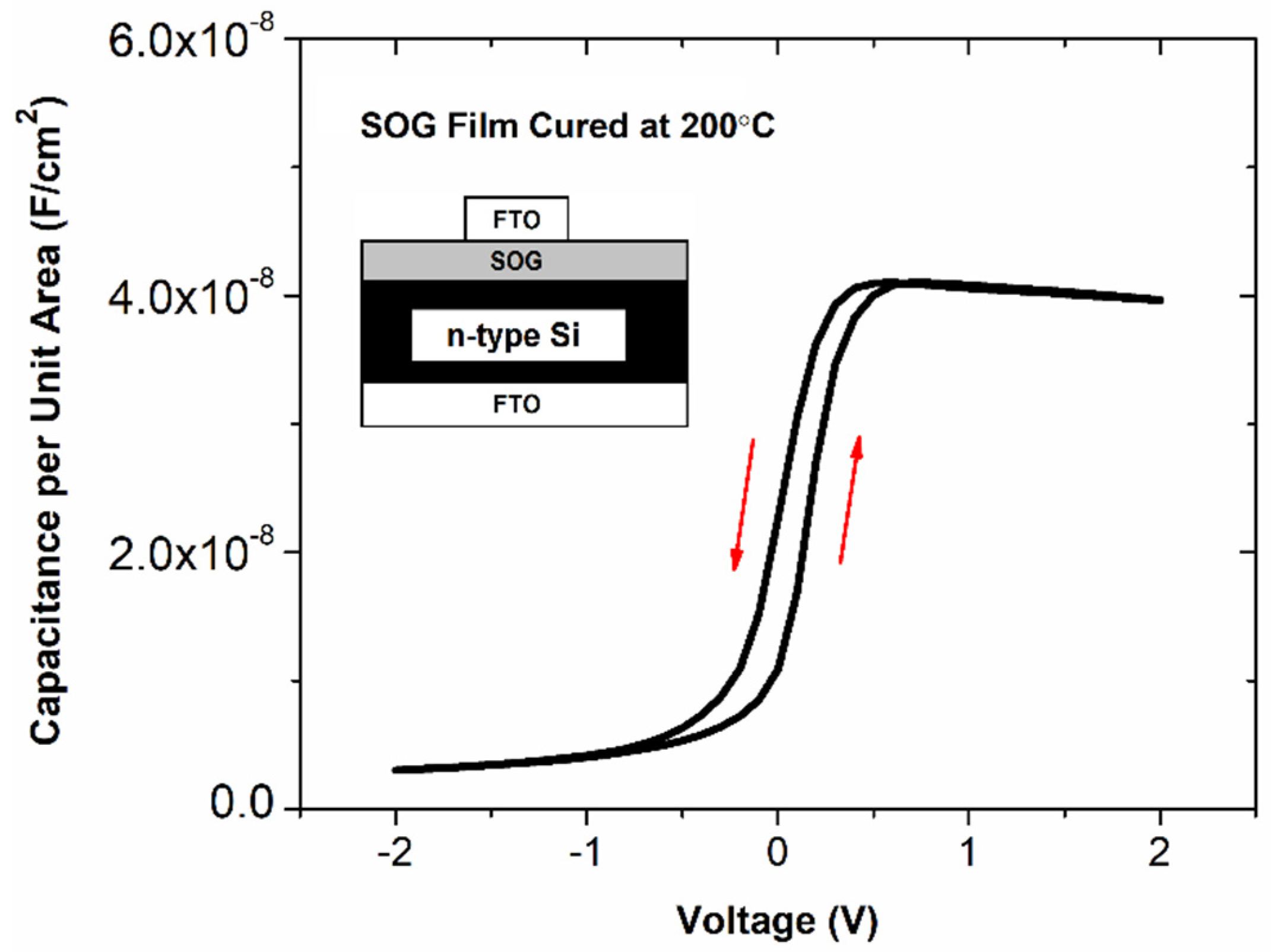
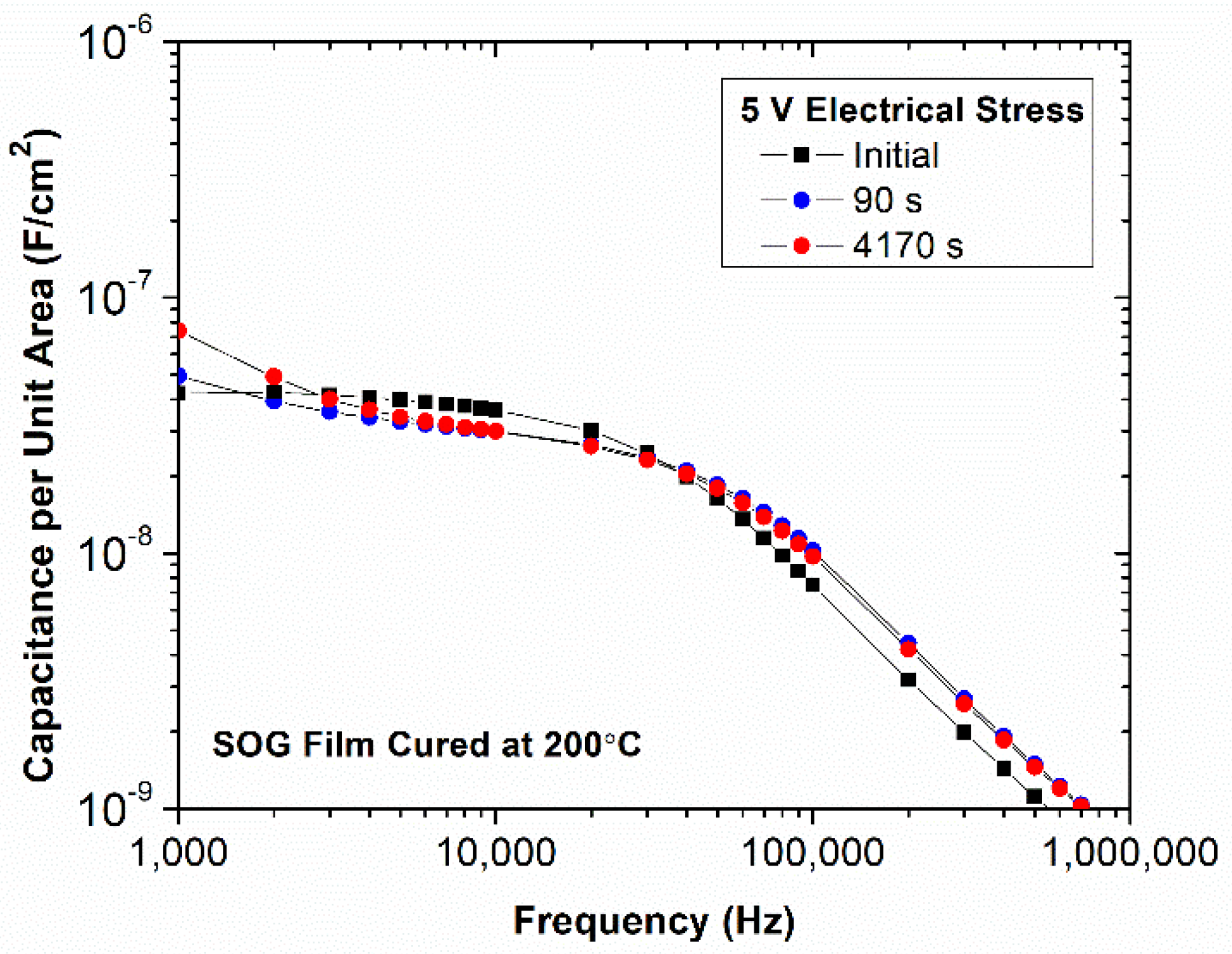
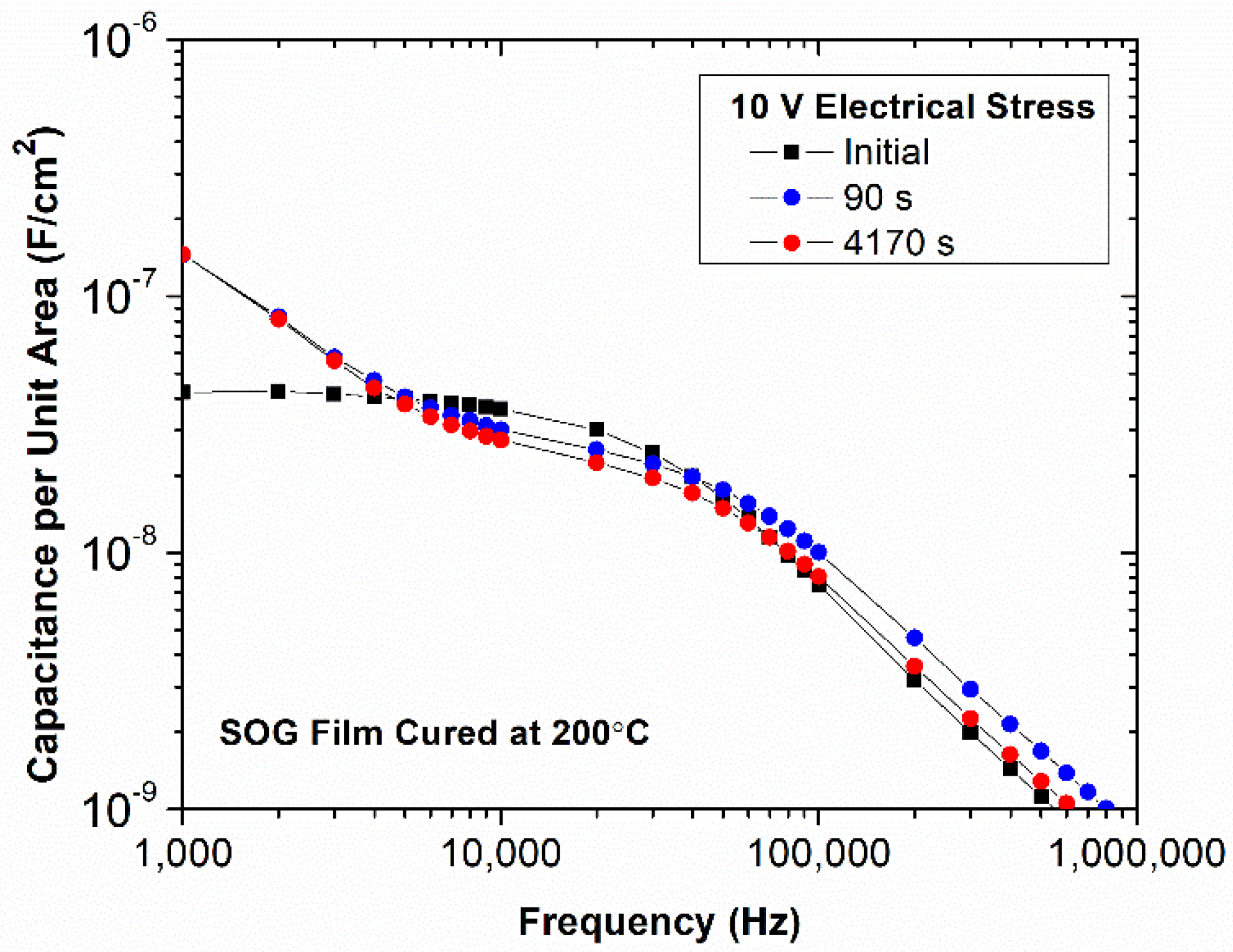
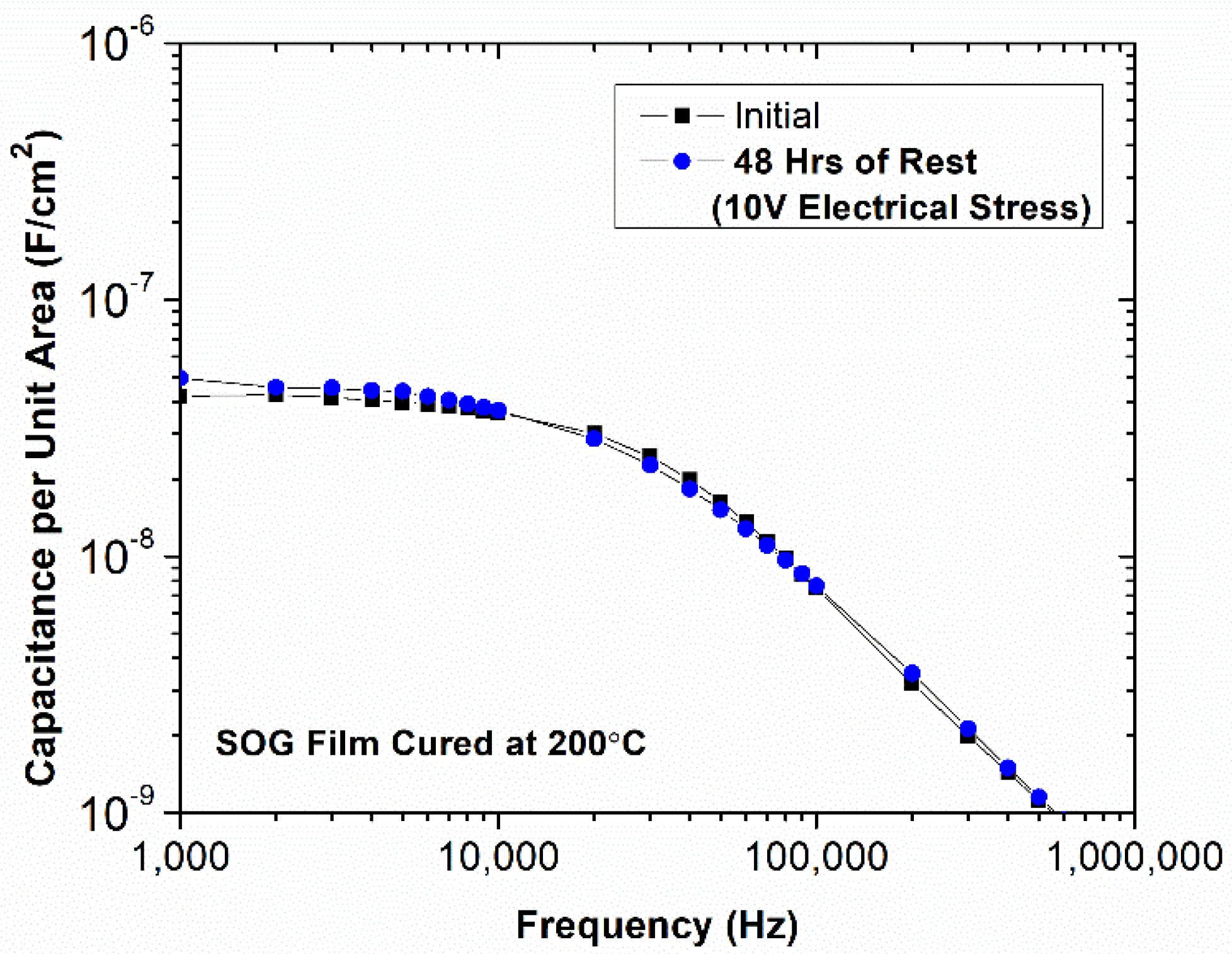

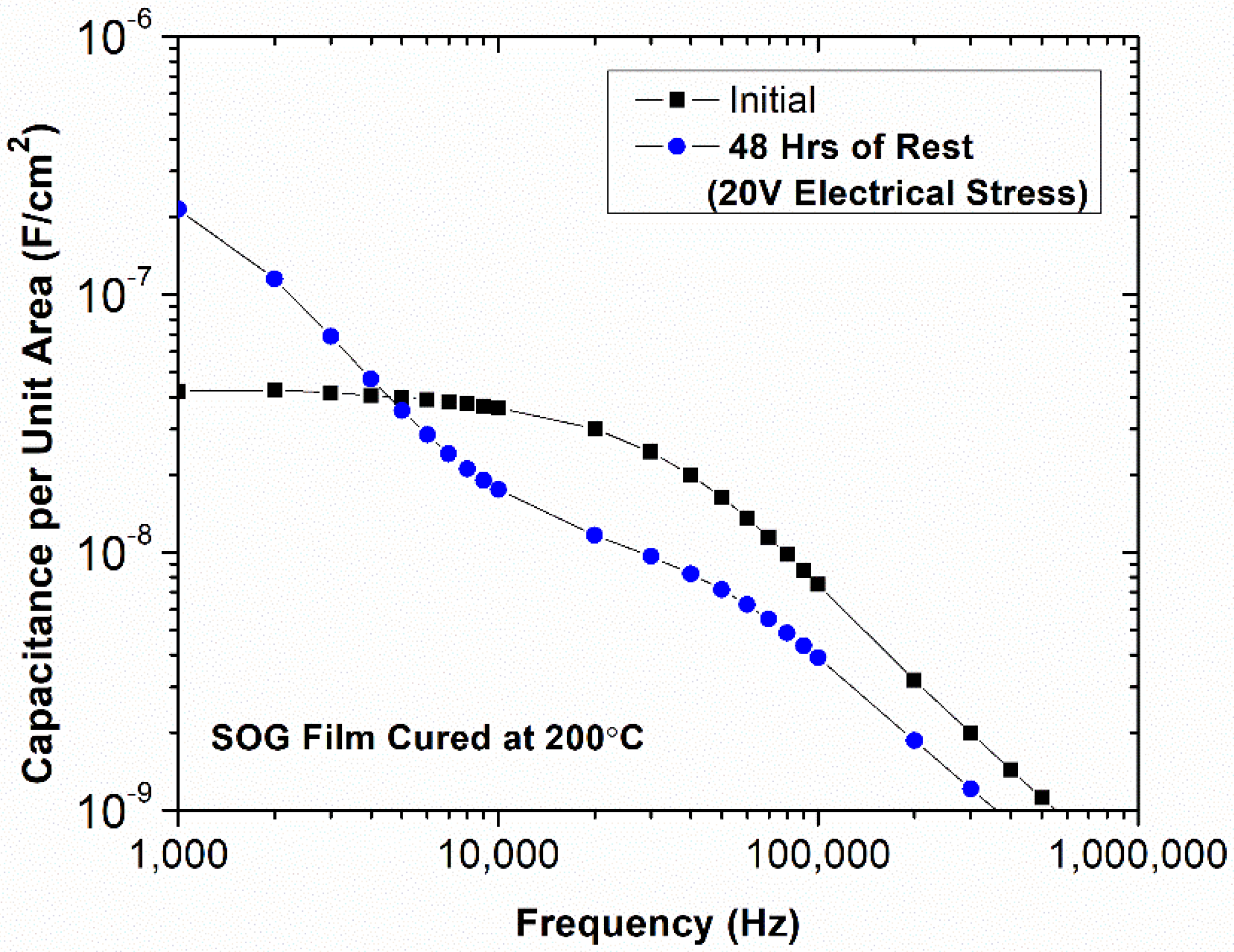
Publisher’s Note: MDPI stays neutral with regard to jurisdictional claims in published maps and institutional affiliations. |
© 2021 by the authors. Licensee MDPI, Basel, Switzerland. This article is an open access article distributed under the terms and conditions of the Creative Commons Attribution (CC BY) license (https://creativecommons.org/licenses/by/4.0/).
Share and Cite
Obregon, O.; Alcantara, S.; Soto, S.; Dominguez, M.A. Effects of Electrical Stress in Solution-Processed Spin-On Glass Dielectric Films: Frequency Dependence. Eng. Proc. 2021, 4, 2. https://doi.org/10.3390/Micromachines2021-09543
Obregon O, Alcantara S, Soto S, Dominguez MA. Effects of Electrical Stress in Solution-Processed Spin-On Glass Dielectric Films: Frequency Dependence. Engineering Proceedings. 2021; 4(1):2. https://doi.org/10.3390/Micromachines2021-09543
Chicago/Turabian StyleObregon, Ovier, Salvador Alcantara, Susana Soto, and Miguel A. Dominguez. 2021. "Effects of Electrical Stress in Solution-Processed Spin-On Glass Dielectric Films: Frequency Dependence" Engineering Proceedings 4, no. 1: 2. https://doi.org/10.3390/Micromachines2021-09543
APA StyleObregon, O., Alcantara, S., Soto, S., & Dominguez, M. A. (2021). Effects of Electrical Stress in Solution-Processed Spin-On Glass Dielectric Films: Frequency Dependence. Engineering Proceedings, 4(1), 2. https://doi.org/10.3390/Micromachines2021-09543





